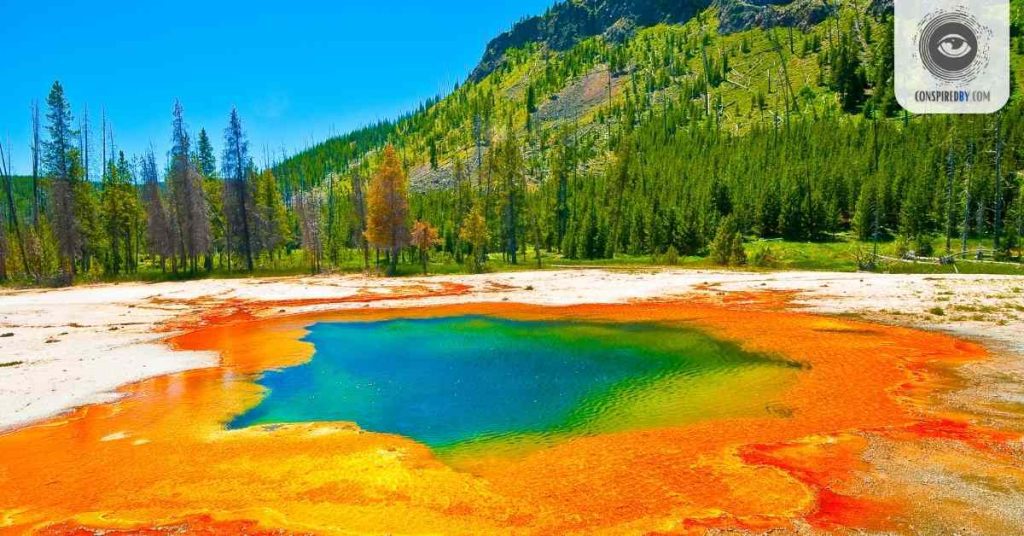Yellowstone’s Supervolcano is one of the World’s largest volcanoes. It’s a region of remarkable geological activity underneath the Yellowstone National Park in the US. Yellowstone’s Supervolcano had 3 enormous eruptions within the last 2.1 million years, creating a Caldera. The first eruption, one of the biggest known to man and coated 5790 square miles of ash.
Some people have been discussing that an eruption is overdue. An eruption of such is capable of massive destruction, and the possibility cannot be discounted.
This article comprises information from sources like Wikipedia, usgs.com, yellowstonepark.com, and LiveScience.com.
Read ahead to get a comprehensive understanding of the separating facts from fiction around Yellowstone’s Supervolcano.
Understanding Yellowstone’s Supervolcano
The USGS defined a supervolcano as “a volcanic center that has had an eruption of magnitude 8 on the Volcano Explosivity Index (VEI), meaning that at one point in time, it erupted more than 1,000 cubic kilometers (240 cubic miles) of material.” The 3 massive eruptions in Yellowstone created the cauldron-shaped hollow known as “Caldera.”
1) Huckleberry Ridge eruption- 2.1 million years ago
2) Mesafalls eruption- 1.3 million years ago
3) Lava Creek eruption- 640000 years ago
There were approximately 80 nonexplosive eruptions that resulted in Basalt vents and rhyolite lava flows on both inside and outside. Yellowstone spans the states of Wyoming, Montana, and Idaho, while 96% of it sits in the state of Wyoming.
The facts about Yellowstone’s Supervolcano
Eruptions were not identified for the month of March, but two were detected in the whole year. A minor earthquake of a magnitude of 3.7 occurred about three miles Southeast of the Lake in Yellowstone National Park. According to the Yellowstone Volcano Observatory (YVO), the current state of the volcano is declared as follows:
YELLOWSTONE (VNUM #325010)
44°25’48” N 110°40’12” W, Summit Elevation 9203 ft (2805 m)
Current Volcano Alert Level: NORMAL
Current Aviation Color Code: GREEN
Furthermore, Mike Poland– geologist and scientist-in-charge of YVO, describes activities and related problems in a monthly video update on the USGS youtube channel. GPS stations in Yellowstone Caldera continuously record subsidence of a few centimeters (1-2 inches) bit by bit since 2015. Research done in 2022 revealed that Yellowstone Caldera holds more liquid molten rock than estimated.
However, these facts seem like an upcoming eruption. Poland said, “This really just confirms what we already know about Yellowstone. That means there’s far less likelihood of a consequential eruption. I find this result reassuring.” However, the probability of another catastrophic eruption is approximately 0.00014%.
There is a significant scientific advancement to predict a possible eruption, and the YVO is observing its activity or state. Indicators usually range from earthquakes and ground deformations, and the system in place can detect an eruption from weeks to years.

What would happen if Yellowstone’s Supervolcano erupted?
It will be like waking a sleeping giant. The damage it causes will not be limited to the surrounding states. The whole of the US will be affected. Further, it will have a massive impact on the climate, and it is assumed that its effects will last for years if not decades. Surrounding states of Montana, Idaho, and Wyoming would be impacted by pyroclastic flows. It could spew ash for thousands of miles across the other parts of the US.
Debunking the myths surrounding Yellowstone’s Supervolcano
There are several misconceptions about the Yellowstone Volcanic system.
One misconception is the eruption will lead to an Armageddon. If an eruption occurs, which is highly unlikely, it will be a hydrothermal eruption.
Another misinformation is that the magma chamber underneath is expanding. There is no evidence to prove any growth in the chambers and improvement in the near-surface magma reservoir. A study by the University of Utah suggests that much of what is found beneath, are partially molten rocks. However, Live Science reveals Poland’s opinion regarding this misconception; “volcanoes don’t work on timelines.”
Another misconception is that Yellowstone is rapidly rising. There has been a rapid rise and subsidence, but they are not leading to an eruption.
@interesting_facts_addict #facts #yellowstone #volcano #nature ♬ WARNING – Slowed – MC ORSEN
Conclusion
Yellowstone supervolcano is endlessly more powerful than typical volcanoes. There were three colossal eruptions 2.1 million years, 1.3 million years, and 640,000 years ago, respectively. Many people conjecture about the next eruption. The majority of media mislead people by addressing misinformation. However, these misconceptions and myths aren’t accurate and cannot be considered along with scientific reasons and calculations.
Such a massive eruption could cause massive damage to climatic changes worldwide.
Ash particles might block the sunlight and decrease the temperature to -10°C. It would even cause a mini ice age.
According to scientists’ calculations, the yearly probability of another caldera-forming eruption is 0.00014%
Also read,


